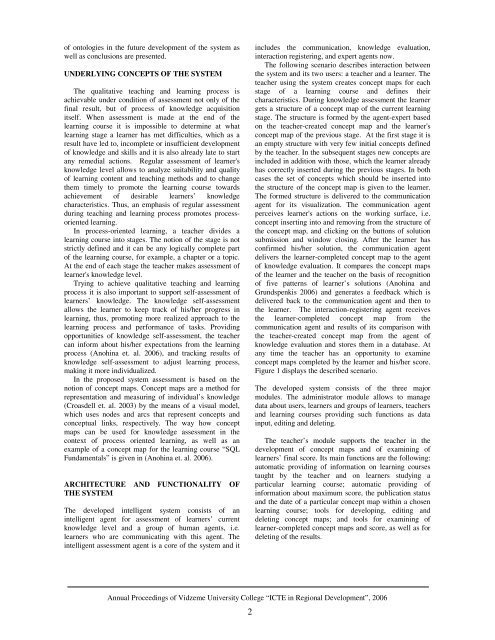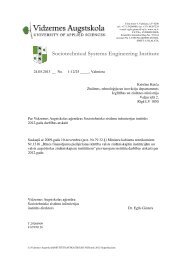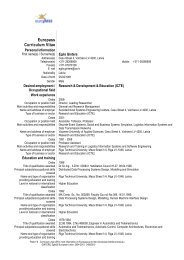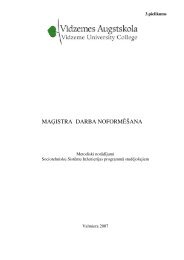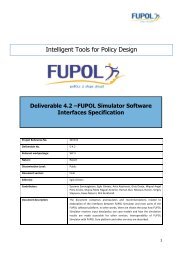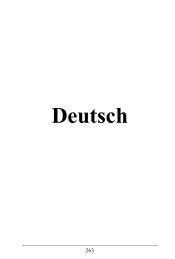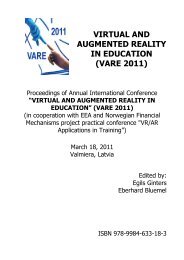Proceedings in pdf format. - Sociotechnical Systems Engineering ...
Proceedings in pdf format. - Sociotechnical Systems Engineering ...
Proceedings in pdf format. - Sociotechnical Systems Engineering ...
Create successful ePaper yourself
Turn your PDF publications into a flip-book with our unique Google optimized e-Paper software.
of ontologies <strong>in</strong> the future development of the system aswell as conclusions are presented.UNDERLYING CONCEPTS OF THE SYSTEMThe qualitative teach<strong>in</strong>g and learn<strong>in</strong>g process isachievable under condition of assessment not only of thef<strong>in</strong>al result, but of process of knowledge acquisitionitself. When assessment is made at the end of thelearn<strong>in</strong>g course it is impossible to determ<strong>in</strong>e at whatlearn<strong>in</strong>g stage a learner has met difficulties, which as aresult have led to, <strong>in</strong>complete or <strong>in</strong>sufficient developmentof knowledge and skills and it is also already late to startany remedial actions. Regular assessment of learner'sknowledge level allows to analyze suitability and qualityof learn<strong>in</strong>g content and teach<strong>in</strong>g methods and to changethem timely to promote the learn<strong>in</strong>g course towardsachievement of desirable learners’ knowledgecharacteristics. Thus, an emphasis of regular assessmentdur<strong>in</strong>g teach<strong>in</strong>g and learn<strong>in</strong>g process promotes processorientedlearn<strong>in</strong>g.In process-oriented learn<strong>in</strong>g, a teacher divides alearn<strong>in</strong>g course <strong>in</strong>to stages. The notion of the stage is notstrictly def<strong>in</strong>ed and it can be any logically complete partof the learn<strong>in</strong>g course, for example, a chapter or a topic.At the end of each stage the teacher makes assessment oflearner's knowledge level.Try<strong>in</strong>g to achieve qualitative teach<strong>in</strong>g and learn<strong>in</strong>gprocess it is also important to support self-assessment oflearners’ knowledge. The knowledge self-assessmentallows the learner to keep track of his/her progress <strong>in</strong>learn<strong>in</strong>g, thus, promot<strong>in</strong>g more realized approach to thelearn<strong>in</strong>g process and performance of tasks. Provid<strong>in</strong>gopportunities of knowledge self-assessment, the teachercan <strong>in</strong>form about his/her expectations from the learn<strong>in</strong>gprocess (Anoh<strong>in</strong>a et. al. 2006), and track<strong>in</strong>g results ofknowledge self-assessment to adjust learn<strong>in</strong>g process,mak<strong>in</strong>g it more <strong>in</strong>dividualized.In the proposed system assessment is based on thenotion of concept maps. Concept maps are a method forrepresentation and measur<strong>in</strong>g of <strong>in</strong>dividual’s knowledge(Croasdell et. al. 2003) by the means of a visual model,which uses nodes and arcs that represent concepts andconceptual l<strong>in</strong>ks, respectively. The way how conceptmaps can be used for knowledge assessment <strong>in</strong> thecontext of process oriented learn<strong>in</strong>g, as well as anexample of a concept map for the learn<strong>in</strong>g course “SQLFundamentals” is given <strong>in</strong> (Anoh<strong>in</strong>a et. al. 2006).ARCHITECTURE AND FUNCTIONALITY OFTHE SYSTEMThe developed <strong>in</strong>telligent system consists of an<strong>in</strong>telligent agent for assessment of learners’ currentknowledge level and a group of human agents, i.e.learners who are communicat<strong>in</strong>g with this agent. The<strong>in</strong>telligent assessment agent is a core of the system and it<strong>in</strong>cludes the communication, knowledge evaluation,<strong>in</strong>teraction register<strong>in</strong>g, and expert agents now.The follow<strong>in</strong>g scenario describes <strong>in</strong>teraction betweenthe system and its two users: a teacher and a learner. Theteacher us<strong>in</strong>g the system creates concept maps for eachstage of a learn<strong>in</strong>g course and def<strong>in</strong>es theircharacteristics. Dur<strong>in</strong>g knowledge assessment the learnergets a structure of a concept map of the current learn<strong>in</strong>gstage. The structure is formed by the agent-expert basedon the teacher-created concept map and the learner'sconcept map of the previous stage. At the first stage it isan empty structure with very few <strong>in</strong>itial concepts def<strong>in</strong>edby the teacher. In the subsequent stages new concepts are<strong>in</strong>cluded <strong>in</strong> addition with those, which the learner alreadyhas correctly <strong>in</strong>serted dur<strong>in</strong>g the previous stages. In bothcases the set of concepts which should be <strong>in</strong>serted <strong>in</strong>tothe structure of the concept map is given to the learner.The formed structure is delivered to the communicationagent for its visualization. The communication agentperceives learner's actions on the work<strong>in</strong>g surface, i.e.concept <strong>in</strong>sert<strong>in</strong>g <strong>in</strong>to and remov<strong>in</strong>g from the structure ofthe concept map, and click<strong>in</strong>g on the buttons of solutionsubmission and w<strong>in</strong>dow clos<strong>in</strong>g. After the learner hasconfirmed his/her solution, the communication agentdelivers the learner-completed concept map to the agentof knowledge evaluation. It compares the concept mapsof the learner and the teacher on the basis of recognitionof five patterns of learner’s solutions (Anoh<strong>in</strong>a andGrundspenkis 2006) and generates a feedback which isdelivered back to the communication agent and then tothe learner. The <strong>in</strong>teraction-register<strong>in</strong>g agent receivesthe learner-completed concept map from thecommunication agent and results of its comparison withthe teacher-created concept map from the agent ofknowledge evaluation and stores them <strong>in</strong> a database. Atany time the teacher has an opportunity to exam<strong>in</strong>econcept maps completed by the learner and his/her score.Figure 1 displays the described scenario.The developed system consists of the three majormodules. The adm<strong>in</strong>istrator module allows to managedata about users, learners and groups of learners, teachersand learn<strong>in</strong>g courses provid<strong>in</strong>g such functions as data<strong>in</strong>put, edit<strong>in</strong>g and delet<strong>in</strong>g.The teacher’s module supports the teacher <strong>in</strong> thedevelopment of concept maps and of exam<strong>in</strong><strong>in</strong>g oflearners’ f<strong>in</strong>al score. Its ma<strong>in</strong> functions are the follow<strong>in</strong>g:automatic provid<strong>in</strong>g of <strong>in</strong><strong>format</strong>ion on learn<strong>in</strong>g coursestaught by the teacher and on learners study<strong>in</strong>g aparticular learn<strong>in</strong>g course; automatic provid<strong>in</strong>g of<strong>in</strong><strong>format</strong>ion about maximum score, the publication statusand the date of a particular concept map with<strong>in</strong> a chosenlearn<strong>in</strong>g course; tools for develop<strong>in</strong>g, edit<strong>in</strong>g anddelet<strong>in</strong>g concept maps; and tools for exam<strong>in</strong><strong>in</strong>g oflearner-completed concept maps and score, as well as fordelet<strong>in</strong>g of the results.Annual <strong>Proceed<strong>in</strong>gs</strong> of Vidzeme University College “ICTE <strong>in</strong> Regional Development”, 20062


